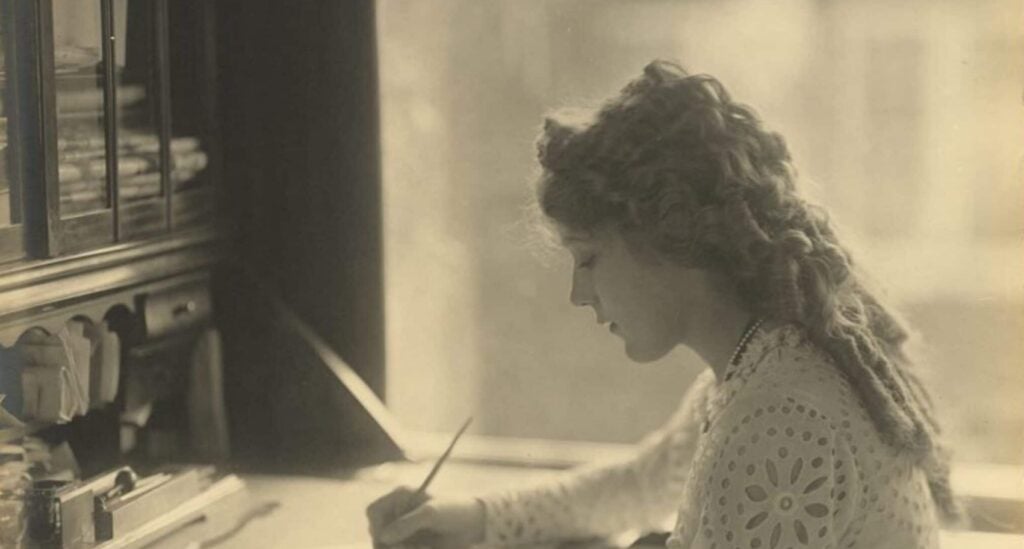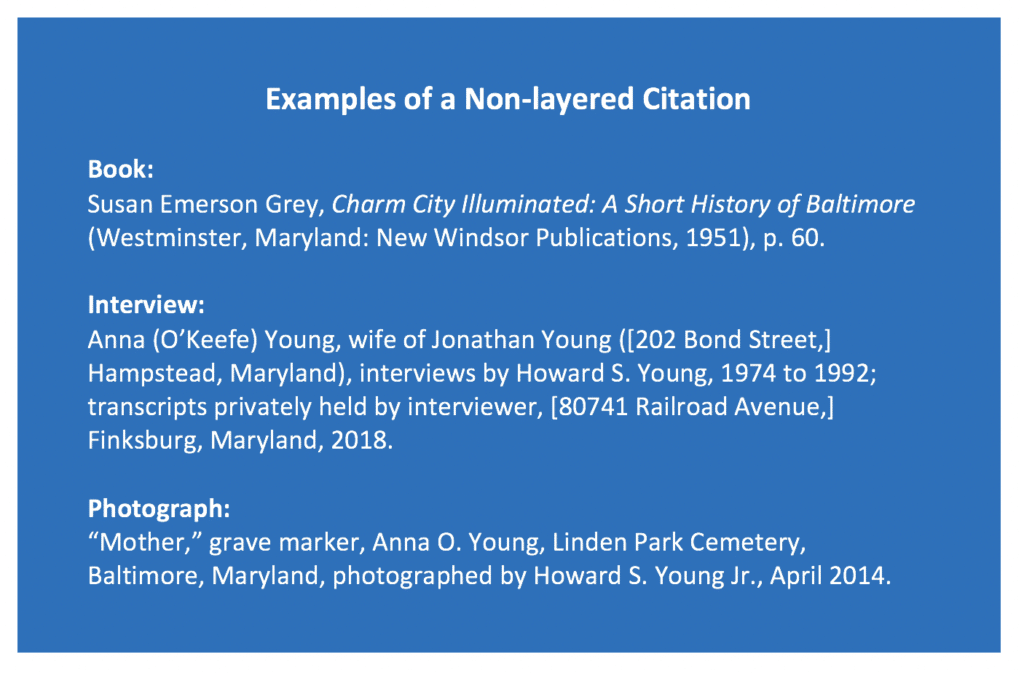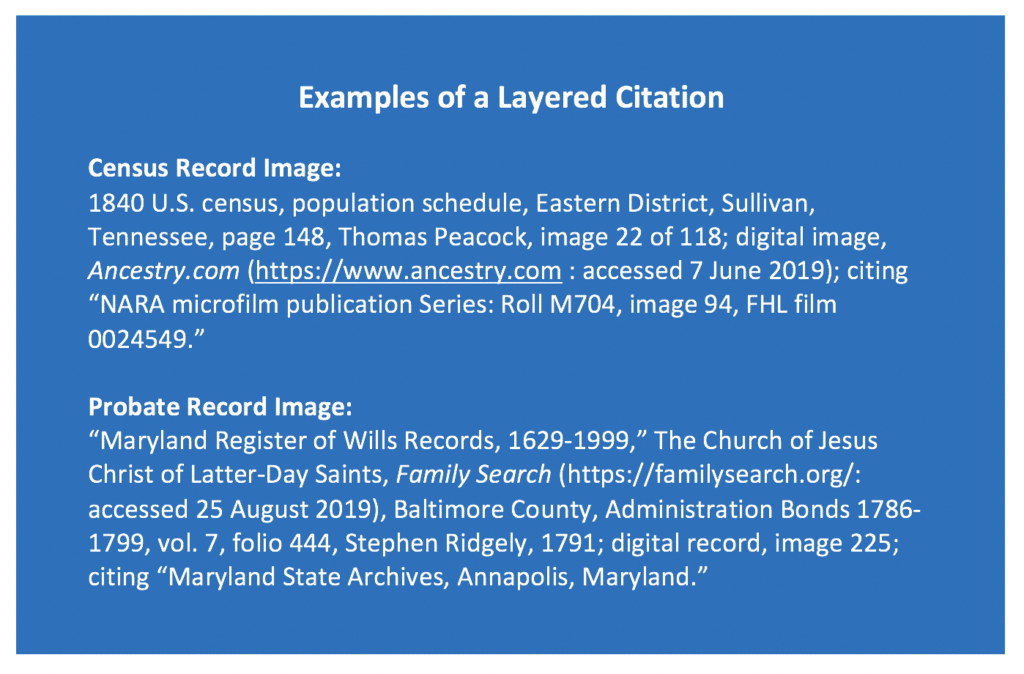By Bridget M. Sunderlin
When all we wish to do is locate our ancestors, and fill in the gaps in our family tree, taking the time to document our sources can seem like an extra, tedious task – one that is certainly not as enjoyable as doing the research itself. But, if we want to create a tree that has true value now and in the future, citing sources is not optional. It’s also not as complicated as you might think. Read on to discover what this process means and how easy it is to get started.
Why and How to Cite Sources in Your Family Tree
What is “Citing a Source”
When we do research on our ancestors and discover new details, these details come from a source. This source – such as a document, a book, a newspaper, or a census record – is responsible for providing the information we are adding to our family tree and it is important that we record it when we add these new facts.
Recording a source is called citing and there are many ways to do this. Many modern research platforms make it easy, such as MyHeritage or Ancestry, by creating citations for us when we add a fact to a person in our tree from their databases. But there are many times when we dig up information from external sites and repositories and we must do this citing ourselves.
Why Cite Your Sources
Learning about our ancestors can be a lot of fun. And, when we discover new details about someone our first instinct is to add it to our family tree and keep moving so we don’t break our momentum. At this stage it can be tempting to not bother to make note of where the information came from.
Perhaps we assume that we will remember, or that others will be able to discover the record just as we did, but this type of thinking leads to a family tree that has little long-term value – and one that will be questioned by every researcher who views it in the future.
There are literally thousands of unsourced trees on the internet and, while they can be fun to peruse, they are mostly worthless to a researcher looking for accurate data. All facts are suspect if they don’t have a source, as we have no way of knowing if the person who added that fact really KNEW that detail was correct or if they just THOUGHT it was.
Don’t be responsible for one of these trees. If you are going to invest time in research it is worthwhile to invest some additional time creating a tree that people will be able to respect and reference in the future. Citing all of your sources ensures that you and others will be able to easily review the records your data came and, as new details emerge about your family, revisit them in a new context.
How to Cite a Source
While there are many ways to create citations, it does not have to be complicated. In its most simple form a source should contain some very basic elements. In this guide we have showcased a paired down method for those who do not have the time or inclination to learn about more elaborate citations, and then we have dived deeper into the process.
For those short on time, below is the absolute simplest way to cite a source. It is not standard, or ideal, but is better than no citation at all. As stated, many large sites like Ancestry create citations for you if you add a record from their database, but you will need to add this information yourself any time you add facts from external sources.
If you find a record and add details to your tree from that record, simply attach the scanned record or a screenshot of the index, and then add, at least, the following details. You will see a spot for this in your tree program. Make sure the document and citation are attached to the fact you are adding, such as a birth date or burial location or, if that is not possible, the person.
Let’s assume that you pulled out a location for your ancestor in 1940 from the 1940 US census, or that you have found a burial date in a published collection of burials created by a reputable source. Here is what to add to your tree with these records.
- Add the Author of the Collection Your Fact Came From – example: US Census Bureau or Adams County Historical Society
- Include the Collection Name – example: 1940 US Census or Adams County Residents 1870-1890
- Show Where in the Collection Your Ancestor Can Be Found – example: Page 18b or Page 98
- Include the Location Where You Found the Collection – example: Ancestry.com or Adam’s County Historical Society, Jamesville, Nebraska
- Include a Direct URL or Call Numbers for a Physical Collection – example: https://search.ancestry.com/cgi-bin/sse.dll?indiv=1&dbid=2442&h=130261113&tid=&pid=&usePUB=true or QE534.2
- Mention the Date you Accessed the Collection – example: 12 July 2020 or 19 May 2000
The above sample citations would look like the following:
US Census Bureau. 1940 US Census. Page 18b. Ancestry.com. https://search.ancestry.com/cgi-bin/sse.dll?indiv=1&dbid=2442&h=130261113&tid=&pid=&usePUB=true. Accessed 12 July 2020
or
Adams County Historical Society. Adam’s County Residents 1870-1890. Page 98. Adam’s County Historical Society. Jamesville, Nebraska. QE534.2. 19 May 2000.
In many citations, as above, the author is listed first. However, for clarity, it makes sense to list the collection title first in some cases as we have done below.
The standard for dates in family history research is dd, mmm, yyyy. Meaning that listing the two digit day, followed by the month (or three letter abbreviation for the month) and then the complete year is preferred. Because different date formats are used across the world (and at different points in history) this method helps to avoid confusion.
To help better understand why this is important, consider that 07/12/2020 could be July 12th or December 7th depending on how it is read. By placing and reading dates in the standard format, and including the month’s name, we can ensure clear communication of our dates to other researchers.
The following format is a more involved version of the citation format above, and includes a good deal more detail. It is closer to a standard and complete citation.
Here is a more detailed option:
- The title of the specific collection – Sixteenth Census of the United States
- Who created it (the original author) – United States of America, Bureau of the Census
- The date the source document was created (if known) – 1940
- The original repository and collection information (if one exists) – National Archives and Records Administration, Washington, D.C. T627, 4,643 rolls
- The location in the collection where the document exists, with detail – Census Place: Palatka, Putnam, Florida; Roll: m-t0627-00615; Page: 18B; Enumeration District: 54-5
- The location where it is hosted online – Ancestry.com
- A URL for the specific document, if online, or call numbers in a repository – https://search.ancestry.com/cgi-bin/sse.dll?indiv=1&dbid=2442&h=130261113&tid=&pid=&usePUB=true
- The date it was accessed by you – 12 July 2020
- Notes, if needed, for clarification – Mary Sanders is listed as Mary Jones in this census because she was briefly married to a man named Ned Jones from 1937 to 1941.
Written out in your records, such a citation would look something like this:
Sixteenth Census of the United States. United States of America, Bureau of the Census. 1940. National Archives and Records Administration, Washington, D.C. T627, 4,643 rolls. Census Place: Palatka, Putnam, Florida; Roll: m-t0627-00615; Page: 18B; Enumeration District: 54-5. Online location, Ancestry.com. https://search.ancestry.com/cgi-bin/sse.dll?indiv=1&dbid=2442&h=130261113&tid=&pid=&usePUB=true. Date accessed 12 July 2020.
Italics, quotation marks and semicolons can be used for clarity and to fit into standard citation style guides, but are not necessary and can be difficult to remember. We will address these a bit later in the article.
Obviously, this information will look quite a bit different if your source is not an online record. Offline records, books, individuals etc will require different information to be entered.
For simple help figuring out how to structure citations by type please read Family Search’s guide to citations here, which includes help for offline and online sources. You may also want to read the gold standard reference on citations and evidence, Evidence Explained by Elizabeth Shown Mills for more detailed help.
Special note: Do not hyperlink text with a URL to your source even if allowed in some programs. Although it may work well at the time, hyperlinks can be removed when copying from program to program. Always include the direct URL in text format as seen above.
Remember, some documentation is better than none – so don’t skip citations because they feel too complicated!
More Help for Citing Your Sources – Non-layered and Layered Citations
As you write citations, you can mentally place them into one of two groups, non-layered and layered. If the artifact you use as your source is in its original form (an original document you have viewed in person or own), it can be written in a non-layered citation.
If, however, the original was digitized and is now an image on a screen (such as in an online database), a layered citation is needed. That holds true for any copy of the original, including microfilm.
Non-layered citations should include the creator, title, type, date and place of publication, and physical location of the artifact. Include the subject of the artifact and date if there is one. Use italics when typing titles. Use quotation marks to identify an article or chapter.
Layered citations should include first, the copy’s creator, title, type, date (ie: date the website was created or updated) and place of publication, and physical location (ie: the website url or microfilm repository) of the copy and the date you accessed the copy online; and second, everything you would include from a non-layered citation regarding the original.
Break the layers with a semicolon. It is important to note that layered citations will include all details about the original and all details about the image or copy. Don’t forget to include your subject and date again.
While professionals needs to follow very careful procedures, even hobbyists should include source citations that offer readers the name, date and location of our sources. In this article we have presented a variety of ways to do this and you can choose to use what suits you the best.
Just remember that choosing not to source your tree will have lasting, negative impacts on your research and will make it incredibly hard for future generations to get value from your work. Choose a method you feel comfortable with, and will have the time and energy to complete, and make it a part of your research routine. You won’t be sorry.
For more help with providing evidence for your research please read Can Your Family Tree Pass the 5 Step Proof Test?, which discusses the Genealogy Proof Standard and how to use it to improve your research. You might also like to read Another Person’s Family Tree is Not a Valid Source. Family History Daily courses also offer detailed help on citing sources.
By Bridget Sunderlin of Be Rooted Genealogy and Melanie Mayo-Laakso, Editor, Family History Daily.
Image: “Mary Pickford writing at a desk” c.1918. Library of Congress.



I am not a genealogist. However, I have been researching for 15 years. Ancestry.com has sources for every bit of information I find. I also teach a free series of Beginning Genealogy Classes. I always present information about the documenting of all sources – because every genealogical search engine has a form! Also, I show several YouTube presenters who show/tell how to complete documentation. I am not going to publish any of my genealogy search, but I do NOT USE these forms at all because the sources are presented in Ancestry and MyHeritage. Why are we reinventing the wheel?
For several years, I’ve been actively building my family tress based ONLY on sources. If it’s not sourced, it’s imagination! I build trees in Ancestry, FamilySearch, and WikiTree. I tried using My Heritage after getting their DNA test, but it was practically worthless after mining sources in the previous three sites. Yes, there’s a lot of un-sourced trees out there, but I peruse them for sources I don’t already have. One person in this discussion mentioned that FamilySearch is good about helping you source your profiles. Unfortunately, there are many, many FS trees that contain no sources at all, or they may contain some “unsourced sources”. FS is suffering from a multitude of people not following “best practices” in genealogy because its open to all. I’ve spent weeks at times chasing down all the multiple profiles (usually due to misspellings) of the same individual and merging them! If these tree builders had used sources, they would realized there’s duplicate profiles out there and would then merge them.
Regarding citing sources, its not easy for the average genealogist. Ancestry has such a wide breadth of sources that you don’t have to worry too much about citing sources that they don’t have. But, when you do, their citing template is the WORST in the world! They really need to simplify the template. FamilySearch has the most user-friendly citing template. WikiTree has gone to great lengths to insure that profiles are sourced and whole it’s approach to citing is more difficult, but its a good learning experience. I think there needs to be a universal movement to source and cite among genealogists.
As an experienced researcher, I find this article very helpful and sad at the same time. As research as changed it is helpful to make the citations that go with the times…. sad because this article has come at a time that I am ready to write and I will have to go back and look up page numbers… thanks for the article.
Great article! Citing sources is intimidating and confusing for sure but this explanation offers a simple structure. I would encourage everyone to cite where they find useful information about their ancestor so that when they finally realize how important it is to do so, they won’t have to go back and try to find it again. That is a very frustrating waste of time. Ask me how I know this…
Excellent article, there are far too many incorrect and unreliable family trees on e.g. Ancestry and My Heritage.
Family Search assists in offering links to e.g. census or civil records, which you can attach to an individual and Wikitree places strong emphasis on the Genealogical Proof Standard being applied to every individual entered on their site.
i believe for future reliability Ancestry and My Heritage both of whom I use need to begin addressing this problem or it will ultimately invalidate a large amount of online data to the detriment of everyone.
Dear Nick, the “citations” are for the historical records you attach to these “dead people”. It provides you a way of returning to the source later, or helps other people see the source of your information. This is complicated! But start by making a note to yourself about where you find information or copy the URL. Most citations come automatically when your source is from a “hint” on ancestry.com or familysearch.org.
Dear Mary, Yes, this is complicated, even for an experienced family tree builder! The good news is that when you attach a source from a “hint” on either familysearch.org or ancestry.com it provides the “citation” automatically! Don’t be discouraged. It may be a long time before you embark on in-depth “research” on your own and will need to remember where you found it. Just have fun and take advantage of the automatic sources that are suggested for you. If you find something on your own, just make a note to yourself about where you found it (in your own words, or copy the URL).. Don’t worry about this precise formula until later if you have a desire to do so.
There is an assumption that readers of the Article have a certain knowledge of building a Tree and therefore using Citations, however as a newbie to Ancestry I do not and found the Article rather intimidating and off putting. I am thinking I shall give up as it is all far too complicated!
I love this straightforward article on citing sources.
Thank you, I have been struggling with citing my sources and am trying to turn over a new leaf! This was straight forward and simple and easy to follow and implement!
Thankyou for the above article. Any help in clarifying the difficulty of creating sources is helpful. However, as most people use a Family History program to record their information, and each program has their own structure and terminology for sources, it is very confusing to translate the excellent examples in your article into the citation structure in Ancestry, or Family Tree Maker. It would be very helpful if you could address this in future articles. Many Thanks.
Why would I have citations for a bunch of dead people on a website?
Thank you for this article. I have been trying to figure out how to cite sources so that others can understand my work. You pointed out a couple of things that I have failed to record. Going forward I will do a better job!